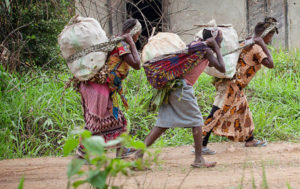I mentioned in my last piece on the “mega-crisis” rocking the Congo that sources familiar with the situation on the ground in North Kivu’s Beni area believe that ethnic cleansing, i.e., forced deportation, of the Nande people is underway. Since late 2014, nearly 1,000 civilians have been murdered, and hundreds of thousands have fled their farms and villages.
I advocated for more thorough research on this topic before the scales of this crisis are tipped towards mass atrocity. I began digging deeper into this “invisible genocide,” as my Congolese source called it, and found many accounts supporting the theory that the Nande were being explicitly targeted by these sustained attacks. The next day, JWW’s representative in the Congo, whom I asked to research this issue, got back to me with several accounts from the field corroborating the contention that many powerful players were colluding to expel the Nande from the land they have occupied for generations.
Beni is incredibly rich in natural resources, particularly gold and oil. The Nande people, who settled in northeastern Congo, have used this fruitful land adroitly, excelling in agriculture and developing trade and successful businesses. While the city of Beni is metropolitan with an admixture of tribes and migrants from other countries, the rural areas in the town’s environs, such as Kamango, Kakuka, Mukoko, Parikingi, Abiolos, Eringeti, Mbau and Mavivi, are almost entirely inhabited by Nande. These are the communities that have been most devastated by the killings.
The Nande’s fertile land and commercial success have sparked resentment among some Congolese, including President Joseph Kabila. On numerous occasions, he has disparaged the Nande and expressed his plan of pushing them out of the Beni area. For example, this past April, in a meeting with some ministers of state in Kingakati, Kabila allegedly said, “I hate these Banande (i.e., Nande people); they think they are the strongest because of their trade. I am able to make them poor.” Instead of trying to stop the attacks in North Kivu, Kabila has said, “The Democratic Republic of Congo can develop and go to elections without Kivu,” essentially confirming that the votes of the majority Nande region are omissible to him.
“I hate these Banande (i.e., Nande people); they think they are the strongest because of their trade. I am able to make them poor.” — President Joseph Kabila
Since the beginning of the massacres in Beni, Kabila has never made a concerted effort to stop the killings. He has offered no compassion, no honest military relief, no humanitarian assistance to the communities displaced by the endemic insecurity. At no time has he ordered national mourning to memorialize the innocent victims or acknowledged their deaths in any other way. Kabila has maintained that the Allied Democratic Forces (ADF) — a rebel group in the DRC — has been singularly responsible for the attacks on the civilian population of the Beni regions, and has silenced—often violently—any discourse that deviates from his narrative. However, the ADF forces have been largely depleted since being pushed out by the Armed Forces of the DRC (FARDC), and they have been encamped around Beni for more than twenty years without ever before perpetrating such brutal and gruesome attacks. This makes it difficult to comprehend how neither the UN’s 20,000-person peacekeeping force in Congo, nor the Congolese army, has been able to stymie this violence or adequately explain its proliferation.
While Congo’s mainstream media perpetuates the narrative that the ADF is responsible for the massacres, informal sources such as bloggers and independent journalists provide more plausible insights by virtue of their ties to local populations, civil society actors, and political activists in North Kivu. More and more of these sources are supporting the proposition that Kabila is behind these attacks. And, he is not alone. Kabila is widely seen by Congolese citizens as a puppet controlled by Rwanda.

Source: Congo Research Group
While several of the attacks may have involved some ADF members, it is highly unlikely that they were orchestrated by the ADF. Some ADF fighters were allegedly conned into attacking civilians. NYU’s respected Congo Research Group (CRG) named the Congolese army’s former commander of local operations, General Muhindo Akili Mundos, as having organized at least some of the massacres by arming members of the ADF and other local groups under false pretenses. He allegedly told the recruits they’d be assisting an insurrection aimed at deposing Congo’s deeply unpopular Kabila, misleading them into participating in attacks that were designed not to unseat Kabila, but to terrorize local people, “particularly members of the Nande ethnic group that makes up much of Beni’s elite class of traders, professionals, and prosperous farmers. The aim…is to clear the area for more compliant ethnic groups, including settlers from Rwanda.”
CRG uncovered that numerous militants whose native language is Kinyarwanda, the language of Rwanda, participated in some of the massacres. Back in 2015, UN peacekeepers, who staged an ambush against would-be perpetrators of a foiled massacre, found a former Rwandan rebel leader and a former Rwandan army officer among the dead. The CRG has also documented numerous instances of soldiers clad in FARDC uniforms among the attackers’ ranks.
Rwanda has long had their sights on Congo’s rich soil, which holds an estimated $24 trillion in natural resources, including oil, gold, diamonds, coltan, and cobalt, among others. In their competition for control over the resource-rich northeast of Congo, President Kagame of Rwanda has effectively rendered the Beni region ungovernable. Rather than protect his land and his peoples, Kabila has facilitated these attacks, leading a local publication called Africa Top News to argue: “the genocide in Beni will stop when everyone understands that it is Rwanda’s Kagame who is behind these atrocities with the complicity of Kabila.”
Above all else, Kabila and his cronies want to maintain control of Congo’s riches. They are part of a corrupt network involving the country’s mining, banking, and telecommunications industries. Although the country appears largely ungovernable, given the conflict situations raging in several parts, this orchestrated chaos is actually Kabila’s modus operandi and the source of his power. According to the International Institute for Strategic Studies, “the DRC’s large territory and the limitations of its security forces have impelled its leaders to employ the divide-and-rule tactics of manipulation, destabilization, and deal-making to establish and maintain relative control….Local and national politicians play ethnic groups against each other….The army provides weapons and equipment, and also conducts operations that are later blamed on rebel groups.”
Eastern Congo alone has roughly seventy armed groups and many are heavily intertwined. With members moving from one group to another, shifting allegiances, following diverse agendas, and crossing borders—many of the fighters don’t even know what they’re fighting for at any given point in time. It is precisely this maelstrom that enables Kabila to maintain control and hide his and Rwanda’s true intentions.
There is mounting evidence to suggest that Kabila, together with Kagame and Museveni, wants to wrestle northeastern Congo from the Nande people, replacing these communities with Rwandans in order to control important trading (and smuggling) routes and steal the resources of the plentiful Beni region. According to a local Congolese website called Beni Lubero, “if there is really need to identify the head of the alleged ADF in Beni, it is Mr. Joseph Kabila, otherwise called the President-in-Office of the Democratic Republic of Congo.” An article by local Nande activist Muhindo Vahumawa claims that the FARDC is not in Beni to prevent violence “but to facilitate the extermination of a people [Nande] in favor of criminals [i.e., former Hutu genocidaires] imported from Rwanda by Kabila.”
Whether this is actually the case remains an open question. Clearly, Kabila has his hands in the mounting violence in Beni, and, clearly, the ADF is not exclusively responsible for these attacks. There definitely seems to be an ethnic component to the killings, but there is insufficient evidence at this time to categorize the situation as genocidal—to use the “G” word at this point would be premature and dilute its meaning. This is not to say that these egregious killings are not completely in violation of international law and in need of immediate intervention.
If forced deportation or other mass atrocity crimes are truly underway, it is crucial for the international community to lift the veil and no longer take anything the Congolese government says at face value. The plight of the Nande must be carefully monitored by the international community, and every effort must be made to stop the violent attacks, uncover the true perpetrators, and to hold them to account.
Congo is desperate for a democratic transition. Putting another puppet in power will only lead to more of the same. Only a fresh start will help the people reclaim their country and begin to disentangle the myriad rebel groups feeding off of Congo’s resources and decimating the civilian population. That’s why the United States needs to be vigilant in maintaining firm pressure on Kabila’s government before, during, and after the elections, including with sanctions that not only target the upper echelons of power but also their intertwined businesses. Insufficient pressure from the United States and other key stakeholders could backfire, motivating the government to intensify its abuses of the Congolese people, and potentially pushing the persecution of the Nande into the realm of ethnic cleansing.


